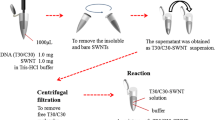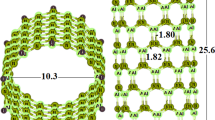Abstract
The interaction of nanomaterials with DNA and proteins is an area of great interest especially in the development of novel biosensors, and recently, it has become the focus of many multidisciplinary researches. DNA intercalating agent acridine orange interrupts the normal function of cellular DNA, leading to the inhibition of gene expressions. Many carcinogenic chemicals damage DNA either by intercalation or by cross-linkage. Numerous repair strategies are available to block the progressive DNA damage caused by DNA intercalators. These strategies aimed to prevent intercalation through the scavenging of the reactive moieties of the intercalators. In this report, we demonstrate binding of halloysite nanotubes (HNT) with a DNA intercalator, acridine orange (AO), through a hydrophobic interaction referred to as “polar bonding.” HNTs are composed of silica on their outer surface and alumina within their inner surface. The inner and outer surfaces of tubular walls confer a resultant negative charge which makes HNT polyanionic in nature, thus enhancing the potential for polar bonding between HNT and amino-substituted AO. This interaction can lead to a metachromatic shift due to π interactions between the aromatic entity of AO and the oxygen plane of the HNT. This shift was confirmed by Fourier transform infrared spectroscopy (FTIR) analysis whereby in the presence of HNT, the intercalator AO, intercalated within the DNA–AO complex, showed affinity for HNT as observed by the shift in FTIR peaks of halloysite nanotubes from 3,623, 1,722, and 1,038 cm−1 to 3,612, 1,706, 1,083, and 963 cm−1.




Similar content being viewed by others
References
Freifelder, D., Davison, P., Geiduschek, P. (1961). Damage by visible light to the acridine orange–DNA complex. Biophysical Journal, 1, 389–400.
Joussein, E., Petit, S., Churchman, J., Righi, T. D. (2005). Halloysite clay minerals: a review. Clay Minerals, 40, 383–426.
Rawtani, D., & Agrawal, Y. K. (2012). Multifarious applications of halloysite nano tubes: a review. Reviews on Advanced Materials Science, 30, 282–295.
Albanese, A., Tang, P. S., Chan, W. C. (2012). The effect of nanoparticle size, shape, and surface chemistry on biological systems. Annual Review of Biomedical Engineering, 14, 1–16.
Lerman, L. S. (1961). Interaction between acridine dyes in the interaction of DNA and acridines. Journal of Molecular Biology, 3, 18–30.
Shamsi, M. H., & Geckeler, K. E. (2008). The first biopolymer-wrapped non-carbon nanotubes. Nanotechnology, 19, 075604 (5 p).
Levis, S. R., & Deasy, P. B. (2003). Use of coated microtubular halloysite for the sustained release of diltiazem hydrochloride and propranolol hydrochloride. International Journal of Pharmaceutics, 253, 145–157.
Mao, Y., Daniel, L., Whittaker, N., Saffiottil, U. (1994). DNA binding to crystalline silica characterized by Fourier-transform infrared spectroscopy. Environmental Health Perspectives, 102, 165–171.
Saeki, K., Sakai, M., Wada, S. (2010). DNA adsorption on synthetic and natural allophones. Applied Clay Science, 50, 493–497.
Dusenbery, D., & Uretz, R. (1972). The interaction of acridine dyes with the densely packed DNA of bacteriophage. Biophysical Journal, 12, 1056–1075.
Nafisi, S., Saboury, A., Keramat, N., Neault, J., Ali, H., Riahi, T. (2007). Stability and structural features of DNA intercalation with ethidium bromide, acridine orange and methylene blue. Journal of Molecular Structure, 827, 35–43.
Lyles, M., & Cameron, I. (2002). Interactions of the DNA intercalator acridine orange, with itself, with caffeine, and with double stranded DNA. Biophysical Chemistry, 96, 53–76.
Shweky, D. G., & Yariv, S. (1999). Metachromasy in clay dye systems adsorption of acridine orange by Na-beidellite. Clay Minerals, 34, 459–467.
Nandini, R., & Vishalakshi, B. (2009). A spectroscopic study of interaction of cationic dyes with heparin. Orbital, 1, 255–272.
Lerman, L. S. (1984). Citation classic—structural considerations in the interaction of DNA and acridines. Current Contents/Life Sciences, 51, 11–19.
Armstron, R. W., Strauss, U. P., Kurucsev, T. (1970). Interaction between acridine dyes and deoxyribonucleic acid. Journal of the American Chemical Society, 92, 3174–3181.
Gersch, N., & Jordan, D. (1965). Interaction of DNA with aminoacridines. Journal of Molecular Biology, 13, 138–156.
Author information
Authors and Affiliations
Corresponding author
Rights and permissions
About this article
Cite this article
Rawtani, D., Agrawal, Y.K. A Study of the Behavior of HNT with DNA Intercalator Acridine Orange. BioNanoSci. 3, 52–57 (2013). https://doi.org/10.1007/s12668-012-0066-1
Published:
Issue Date:
DOI: https://doi.org/10.1007/s12668-012-0066-1




